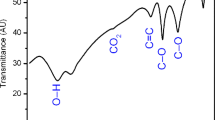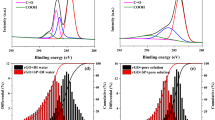Abstract
The presence of a highly alkaline environment or large amounts of Ca2+ in concrete exerts a great influence on the dispersion of graphene oxide (GO) particles. Therefore, the development of a highly efficient GO dispersant to adapt to complex concrete environments is important. In this work, novel phosphate-modified small molecular polydentate polymers were synthesized and used as efficient dispersants for cement and high-concentration GO solutions. The chemical structure of the polymers was confirmed by 1H NMR and IR spectroscopy, and the effect of adsorption groups on the adsorption ability of polymers was studied by using adsorption experiments and theoretical calculations. Results showed that the dispersant inositol hexaphosphate–methoxy polyether (IHP-MP) features a high adsorption equilibrium constant and strong adsorption ability. IHP-MP exhibited not only good water-reducing and slump-retaining properties but also remarkable cement hydration-retarding effects due to its numerous phosphate groups. IHP-MP could be used as an auxiliary GO dispersant with the comb polymer PCE to effectively reduce the viscosity and improve the stability of GO solutions. SEM, TGA and IR characterization indicated that IHP-MP strongly interacts with the surface groups of GO particles.
Graphic Abstract
























Similar content being viewed by others
References
Geim AK, Novoselov KS (2007) The rise of graphene. Nat Mater 6(3):183–191
Du H, Dai Pang S (2015) Enhancement of barrier properties of cement mortar with graphene nanoplatelet. Cem Concr Res 76:10–19
Du H, Gao HJ, Dai Pang S (2016) Improvement in concrete resistance against water and chloride ingress by adding graphene nanoplatelet. Cem Concr Res 83:114–123
Chen SJ, Li CY, Wang Q, Duan WH (2017) Reinforcing mechanism of graphene at atomic level: friction, crack surface adhesion and 2D geometry. Carbon 114:557–565
Lu Z, Hou D, Xu B, Li Z (2015) Preparation and characterization of an expanded perlite/paraffin/graphene oxide composite with enhanced thermal conductivity and leakage-bearing properties. RSC Adv. 5(130):107514–107521
Lu Z, Chen G, Hao W, Sun G, Li Z (2015) Mechanism of UV-assisted TiO2/reduced graphene oxide composites with variable photodegradation of methyl orange. RSC Adv. 5(89):72916–72922
Gong X, Teoh WY (2015) Modulating charge transport in semiconductor photocatalysts by spatial deposition of reduced graphene oxide and platinum. J Catal 332:101–111
Mahmoudi N, Simchi A (2017) On the biological performance of graphene oxide-modified chitosan/polyvinyl pyrrolidone nanocomposite membranes: in vitro and in vivo effects of graphene oxide. Mater. Sci. Eng. C70:121–131
Long WJ, Wei JJ, Ma HY et al (2017) Dynamic mechanical properties and microstructure of graphene oxide nanosheets reinforced cement composites. Nanomaterials 7:407–412
Mokhtar MM, Abo-El-Enein SA, Hassaan MY et al (2017) Mechanical performance, pore structure and micro-structural characteristics of graphene oxide nano platelets reinforced cement. Constr Build Mater 138:333–339
Qin H, Wei W, Hu YH (2017) Synergistic effect of graphene-oxide-doping and microwave-curing on mechanical strength cement. J Phys Chem Solids 103:67–72
Ghazizadeh S, Duffour P, Skipper NT et al (2017) An investigation into the colloidal stability of graphene oxide nano-layers in alite paste. Cem Concr Res 99:116–128
Li X, Korayem AH, Li C, Liu Y, He H, Sanjayan JG et al (2016) Incorporation of graphene oxide and silica fume into cement paste: A study of dispersion and compressive strength. Constr Build Mater 123:327–335
Lu ZY, Li XY, Hanif A, Chen BM, Parthasarathy P, Yu JG, Li ZJ (2017) Early-age interaction mechanism between the graphene oxide and cement hydrates. Constr Build Mater 152:232–239
Bonen D, Sakar SL (1995) The superplasticizer adsorption capacity of cement paste, pore solution composition, and parameters affecting flow loss. Cem Concr Res 25:1423–1434
Zhu J, Zhang G, Miao Z, Shang T (2012) Synthesis and application of a new vinylcopolymer superplasticizer. Colloids Surf A 412:101–107
Plank J, Pöllmann K, Zouaoui N, Andres PR, Schaefer C (2008) Synthesis and performance of methacrylic ester based polycarboxylate superplasticizers possessing hydroxy terminated poly(ethylene glycol) side chains. Cem Concr Res 38:1210–1216
Liebscher M, Lange A, Schröfl C, Fuge R, Mechtcherine V, Plank J, Leonhardt A (2017) Impact of the molecular architecture of polycarboxylate superplasticizers on the dispersion of multi-walled carbon nanotubes in aqueous phase. J Mater Sci 52:2296–2307. https://doi.org/10.1007/s10853-016-0522-3
Moedritzer K, Irani R (1996) The direct synthesis of α-aminomethylphosphonic acids. Mannich-type reactions with orthophosphorous acid. J Org Chem 31:1603–1607
Turrin CO, Hameau A, Caminade AM (2012) Application of the Kabachnik–Fields and Moedritzer–Irani procedures for the preparation of bis(phosphonomethyl)amino-and bis[(dimethoxyphosphoryl) -methyl]amino-Terminated Poly(ethylene glycol). Synthesis 44:1628–1630
Fields EK (1952) The synthesis of esters of substituted amino phosphonic acids. J Am Chem Soc 74:1528–1531
Kukhar VP, Hudson HR (eds) (2000) Aminophosphonic and aminophosphinic acids: chemistry and biological activity. Wiley, Chichester
Poupot M, Griffe L, Marchand P et al (2006) Design of phosphorylated dendritic architectures to promote human monocyte activation. FASEB J 13:2339–2351
Matty JM, Tomson MB (1988) Effect of multiple precipitation inhibitors on calcium carbonate nucleation. Appl Geochem 3:549–556
Fang JL, Li Y, Ye XR et al (1993) Passive films and corrosion protection due to phosphonic acid inhibitors. Corrosion 49:266–271
Ran QP, Ma JF, Wang T, Zhao HX, Song FY, Fan SM, Yang Y, Lyu ZF, Liu JP (2016) Synthesis, characterization and dispersion properties of a series of bi(phosphonic acid)amino-terminated polymers. Colloid Polym Sci 294:189–198
Ma JF, Shang YZ, Peng CJ, Liu HL, Zheng SZ, Zhao HX, Qi S, Ran QP (2020) Synthesis, characterization, and performance of novel phosphate-modified polymers as air-entraining agents. Constr Build Mater 232:117231
Frisch MJ, Trucks GW, Schlegel HB et al (2009) Gaussian 09, revision A. 1. Gaussian Inc., Wallingford
Mennucci B, Tomasi J (1997) Continuum solvation models: a new approach to the problem of solute’s charge distribution and cavity boundaries. J Chem Phys 106(12):5151–5158
Peng JH, Qu JD, Zhang JX, Chen MF, Wan TZ (2005) Adsorption characteristics of water-reducing agents on gypsum surface and its effect on the rheology of gypsum plaster. Cem Concr Res 35(3):527–531
Bouhamed H, Boufia S, Magnin A (2007) Dispersion of alumina suspension using comb-like and diblock copolymers produced by RAFT polymerization of AMPS and MPEG. J Colloid Interface Sci 312(2):279–291
Shaw DJ (1992) Introduction to Colloid and Surface Chemistry. Butterworth-Heinemann, Oxford
Reese JD, Plank J (2011) Adsorption of polyelectrolytes on calcium carbonate-Which thermodynamic parameters are driving this process? J Am Ceram Soc 94(10):3515–3522
Ma JF, Wang T, Qi S, Fan SM, Zheng SZ, Ran QP (2018) Effects of structure on the properties of low-molecular-weight superplasticizer using phosphonate as the adsorption group. Colloid Polym Sci 296:503–514
Wang YW, Shu X, Liu JP, Ran QP (2018) Conformational properties and the entropic barrier in the ‘‘head-on’’ adsorption of a single polymer chain towards a flat surface. Soft Matter 14:2077–2083
Kong FR, Pan LS, Wang CM, Zhang DL, Xu N (2016) Effects of polycarboxylate superplasticizers with different molecular structure on the hydration behavior of cement paste. Constr Build Mater 105:545–553
Funding
We are grateful to the financial support from the National Science Fund for Distinguished Young Scholars (51825203), the National Natural Science Foundation of China (Nos. 21476072, 21705067) and the Fundamental Research Funds for the Central Universities.
Author information
Authors and Affiliations
Corresponding authors
Ethics declarations
Conflict of interest
The authors declare that no competing financial interest.
Additional information
Publisher's Note
Springer Nature remains neutral with regard to jurisdictional claims in published maps and institutional affiliations.
Electronic supplementary material
Below is the link to the electronic supplementary material.
Rights and permissions
About this article
Cite this article
Ma, J., Zhao, H., Shang, Y. et al. Synthesis of a small molecular polydentate polymer IHP-MP and its application to cement or graphene oxide dispersion via strong interactions between adsorption groups and interfaces. J Mater Sci 55, 4701–4716 (2020). https://doi.org/10.1007/s10853-019-04338-2
Received:
Accepted:
Published:
Issue Date:
DOI: https://doi.org/10.1007/s10853-019-04338-2




